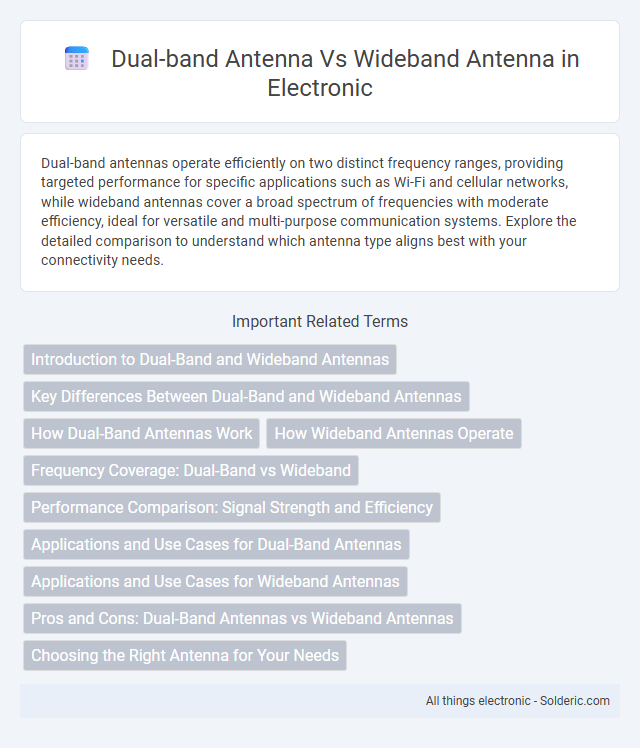Dual-band antennas operate efficiently on two distinct frequency ranges, providing targeted performance for specific applications such as Wi-Fi and cellular networks, while wideband antennas cover a broad spectrum of frequencies with moderate efficiency, ideal for versatile and multi-purpose communication systems. Explore the detailed comparison to understand which antenna type aligns best with your connectivity needs.
Comparison Table
| Feature | Dual-Band Antenna | Wideband Antenna |
|---|---|---|
| Frequency Coverage | Two specific frequency bands | Broad frequency range, multiple bands |
| Use Case | Targeted applications needing two bands (e.g., Wi-Fi 2.4GHz & 5GHz) | Flexibility in applications across various frequencies |
| Complexity | Moderate design complexity | Higher design complexity |
| Cost | Generally lower cost | Typically higher cost |
| Performance | Optimized performance on two bands | Good performance over wide frequency range but less optimized per band |
| Size | Compact due to focused bands | Usually larger to accommodate wide range |
| Examples | 802.11ac Wi-Fi antennas | Software-defined radio antennas |
Introduction to Dual-Band and Wideband Antennas
Dual-band antennas operate efficiently on two distinct frequency bands, making them ideal for devices that require connectivity across separate communication standards, such as Wi-Fi and LTE. Wideband antennas, in contrast, cover a broad range of frequencies with a single antenna design, supporting multiple services and reducing the need for multiple antennas. Choosing the right antenna depends on Your specific frequency requirements and the communication protocols involved.
Key Differences Between Dual-Band and Wideband Antennas
Dual-band antennas operate on two specific frequency bands, providing optimized performance and reduced interference for targeted applications like Wi-Fi at 2.4 GHz and 5 GHz. Wideband antennas cover a broader range of frequencies, enabling compatibility with multiple communication standards but often at the expense of peak efficiency in any single band. Choosing between dual-band and wideband antennas depends on the balance between frequency specificity and versatility required by the wireless system design.
How Dual-Band Antennas Work
Dual-band antennas operate by incorporating two distinct resonant frequencies within a single antenna structure, allowing efficient transmission and reception in two separate frequency bands. Their design often includes techniques like separate radiating elements, stacked patches, or antenna elements with different electrical lengths to achieve dual-frequency operation. You benefit from improved connectivity and device compatibility without the need for multiple antennas by using dual-band antennas.
How Wideband Antennas Operate
Wideband antennas operate by utilizing multiple resonant frequencies across a broad spectrum, allowing them to capture a wide range of signals efficiently. Unlike dual-band antennas designed for two specific frequency bands, wideband antennas employ specialized designs such as log-periodic or spiral geometries to maintain consistent performance over extensive frequency ranges. This capability makes wideband antennas ideal for applications requiring versatile signal reception, including spectrum monitoring and multi-standard communication systems.
Frequency Coverage: Dual-Band vs Wideband
Dual-band antennas operate on two distinct frequency ranges, providing targeted performance for specific bands such as 2.4 GHz and 5 GHz, which is ideal for applications requiring clear separation between frequencies. Wideband antennas cover a broad spectrum of frequencies, often ranging from several hundred MHz to several GHz, offering greater versatility and reducing the need for multiple antennas in varied signal environments. Your choice depends on whether you need optimized performance at specific bands or flexible, wide frequency coverage for diverse wireless applications.
Performance Comparison: Signal Strength and Efficiency
Dual-band antennas typically offer stronger signal strength and higher efficiency within their specific frequency ranges, optimizing performance for targeted applications such as Wi-Fi at 2.4 GHz and 5 GHz bands. Wideband antennas provide broader frequency coverage but may exhibit reduced gain and lower signal efficiency due to the trade-off between bandwidth and resonance optimization. Signal attenuation is often minimized in dual-band designs, whereas wideband antennas prioritize versatility over peak performance in signal strength.
Applications and Use Cases for Dual-Band Antennas
Dual-band antennas are widely used in applications requiring efficient communication across two distinct frequency bands, such as Wi-Fi routers supporting both 2.4 GHz and 5 GHz bands to optimize signal performance and reduce interference. These antennas are ideal for smartphones, IoT devices, and wireless networks where reliable connectivity in multiple frequency ranges enhances user experience and device functionality. Your choice of a dual-band antenna can improve network flexibility and compatibility in environments demanding versatile frequency operation.
Applications and Use Cases for Wideband Antennas
Wideband antennas are ideal for applications requiring coverage across multiple frequency bands, such as advanced communication systems, spectrum monitoring, and signal intelligence. Their ability to operate over a wide frequency range makes them suitable for military, aerospace, and commercial wireless networks where versatility and signal reliability are critical. Your choice of a wideband antenna ensures efficient performance in environments demanding dynamic frequency adaptability and broad spectrum access.
Pros and Cons: Dual-Band Antennas vs Wideband Antennas
Dual-band antennas offer targeted frequency coverage with better performance and lower interference in specific bands but lack flexibility for broader applications. Wideband antennas cover a wide range of frequencies, providing versatility and simplified setup for various devices, though they may suffer from reduced gain and increased noise. Choosing between them depends on your need for focused signal quality versus broad compatibility.
Choosing the Right Antenna for Your Needs
Dual-band antennas operate on two specific frequency ranges, providing targeted performance ideal for applications requiring focused signal reception and transmission. Wideband antennas cover a broader spectrum, offering versatility for environments with multiple frequency signals but may sacrifice some signal strength or clarity. Your choice depends on whether you need optimized performance for specific frequencies (dual-band) or flexibility across a wide range (wideband).
dual-band antenna vs wideband antenna Infographic

 solderic.com
solderic.com